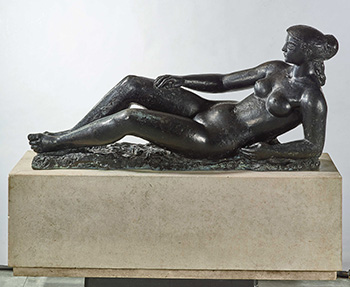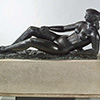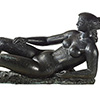ILLUSTRATED:
Musée Volti , Combier imprimeur Mâcon, Nice, 1981, color illustrated, p.13, no. 8 (titled Nu allongé )
Volti , Madeleine Servera-Boutefoy, Serre Editeur, Nice, 2006, color illustrated, p. 24
Catalogue Note:
FEMME DE MÉDITERRANNÉ
Born in Italy, Antoniucci Volti (1915 - 1989) was a renowned French artist, sculptor, and painter. His artistic style was first influenced by classical Mediterranean figurative art and then later inspired by the abstract body sculpture techniques of contemporary art.
There are only six sculptures of “Nikaia-Nu Allongé” in the world and the Musée Volti in southern France also has one of the sculptures in its collection. The sculpture was created in 1964 when the artist was in a technically-mature stage and producing works freely without restraint. The nude female figure is slender with the perfect proportion of slimness and fleshiness. She is reclining in a leisurely manner while facing upwards, the lines formed by her limbs are fluid and streamlined, her breasts are full and firm, her lower abdomen slightly rounded, her left arm is pushed back and bended at the elbow to support her weight, her right arm is extended to the front with her hand resting on her leg, while her legs are extended in the same direction as her line of sight. The right-angled triangle three-dimensional structure is formed from a series of arcs which create a multi-perspective plane. The work expresses both a sense of movement and a sense of presence, resulting in beautifully and perfectly proportioned masterpiece.
The symbols and icons of the twentieth entered a new era and development in sculpturing was no longer content to be restricted to the re-presentation of objects and forms, instead, artworks began to convey an implied narrative and the subjective emotions of the creator. After the age of Auguste Rodin and his four most renowned disciples, Aristide Maillol, Antoine Bourdelle, François Pompon, and Camille Claudel, modern sculpture and painting developed a co-existence where the works stemmed from the perspective of form. Even with the progress of time, the pursuit for a sense of har mony and balance, as well as the aesthetic of for m is still a shared trait of the human society. Visually, we still have high expectations and standards when it comes to the level of finesse in lines, especially the contours of the human body depicted by the hands of artists.
The response to this high aesthetic ideal came into being during WWI, Antoniucci Volti was one of the very few artists who continued to grow and develop their personal styles after the war. Apart from a few animal forms, the full-figured body contours of the Femme de Méditérannée were the lifelong creative pursuit of the artist. His complete art academy training had provided him with a solid foundation. The shapes and poses of his sculptures take on many variations, sometimes to even resemble spherical objects with a solid and firm structure, but even so, it does not detract from the sense of harmony and simple post-war restraint. The attention of the viewer is focused on the expression of the overall form, the pupilless almond-shaped eyes and the tied-back hairdo diminishes its resemblance to real people, which is a special feature of Volti's own trademark.
The family of the artist came from Italy and his father was a professional stone-craftsman, the family moved to France in 1920. At age 17, Volti entered the École Nationale des Arts Décoratifs de Nice and won the gold prize at the Marseilles Art Fair in the same year. He then entered the École Nationale des Beaux-Arts in Paris and joined the studio of the sculptor Jean Boucher. In 1936, he won second prize at the Prix de Rome and an award from l'Ecole des Beaux Arts de Paris, Institut de France respectively. In 1943, a bomb destroyed Volti's studio, but it was also the rebirth of his life in artistic creativity. The artist picked up his chisel once again and carved the word “Volti” and began his journey as a professional artist.
In 1945, he received his first government-commissioned project, his 1952 work “Harmonie” is still in the collection of the Musée des Beaux-Arts de la Ville de Paris. In 1956, he exhibited in the International Contemporary Sculpture Exhibition held at the Musée Rodin in Paris. In 1959, a retrospective exhibition was organized at the Palais de la Méditerranée in Nice. In 1963, he was awarded the Ordre des Arts et des Lettres (Order of Arts and Letters) and in 1967, he was selected as vice-chairman of the Salon d'Automne in Paris. In 1981, the Musée Volti was established through a merger with the Citadelle de Villefranche-sur-Mer. As one of France's representative contemporary sculptors, the works of Volti are still much loved by collectors all over the world even though he passed away in 1989. The Ministry of For eign Affairs of France had organized a large-scale solo retrospective exhibition for Volti who served as a representative artist of France for the 50th anniversary of the China- France relations, the exhibition toured in five major cities around China which took place from 2014-2015.


